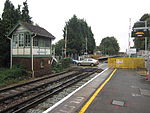Wildwood Discovery Park
1999 establishments in EnglandBuildings and structures in KentCity of CanterburyParks and open spaces in KentUse British English from June 2015 ... and 2 more
Zoos established in 1999Zoos in England
Wildwood Discovery Park now known as the Wildwood Trust, is a woodland discovery park in Herne, near Canterbury Kent, England. It features over fifty species of native British animals such as deer, badgers, wild boar, wolves and brown bear. It is located on the main road A291 between Herne Bay and Canterbury. Wildwood Trust is a Registered Charity in England, No 1093702, whose aim is to save British Wildlife from extinction and reintroduce recently made extinct animals such as European beaver, wild boar and modern tarpan (konik). Visitors to the park can see British animals species past and present, with the animals set in natural enclosures.
Excerpt from the Wikipedia article Wildwood Discovery Park (License: CC BY-SA 3.0, Authors).Wildwood Discovery Park
Wealden Forest Park, Canterbury
Geographical coordinates (GPS) Address Nearby Places Show on map
Geographical coordinates (GPS)
| Latitude | Longitude |
|---|---|
| N 51.331111111111 ° | E 1.1191666666667 ° |
Address
Wealden Forest Park
Wealden Forest Park
CT6 7LG Canterbury
England, United Kingdom
Open on Google Maps








